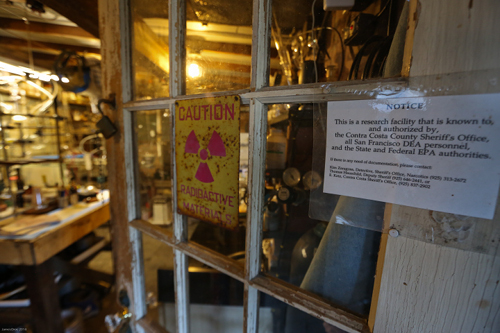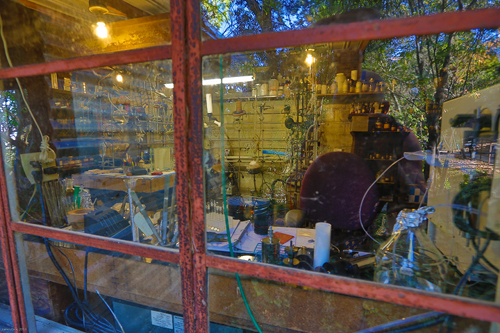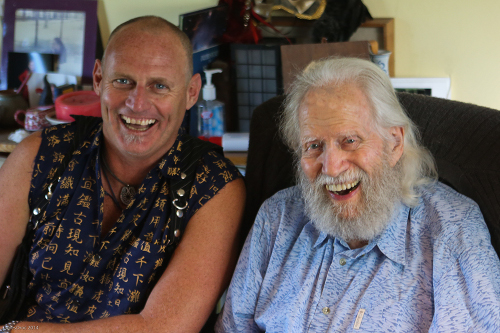This article is Part Two in a series. Read Part One here.
‘I first explored mescaline in the late '50s, three-hundred-fifty to 400 milligrams. I learned there was a great deal inside me.’ — Alexander Shulgin, LA Times, 1995
If there is ever a Psychedelic Hall of Fame, the section on chemists will be small, since there have only really been two giants in this field — Albert Hofmann, who first synthesized LSD-25 and psilocybin (and later isolated that compound from the magic mushroom specimens provided by R. Gordon Wasson), and Alexander ‘Sasha’ Shulgin, who seems to have invented nearly everything else. (So great are the shadows of these two men that twin statues of them facing each other should be the Hall’s entranceway arch.) However when the remarkable volume PiHKAL; A Chemical Love Story [1] first appeared in 1991, few people outside of the psychedelic community in California knew about Sasha and the quiet existence that he and his wife Ann (the co-author of both PiHKAL and TiHKAL) lived; and those that knew of him knew mostly the fact that he was the ‘popularizer’ of the empathogen MDMA.
MDMA had first been synthesized in 1912; it was later used by in the CIA’s Project MK-ULTRA studies in 1953-54; these reports were declassified in 1973; Shulgin then synthesized the compound and tried it himself in 1976 for the first time after hearing accounts of its effects from his students at the University of California, Berkeley. Shulgin liked to call MDMA his ‘low-calorie martini’, and introduced it to numerous friends and colleagues, including the noted psychotherapist Leo Zeff, who was so impressed with the compound that he came out of retirement to train psychotherapists in its use.
MDMA grew in popularity in the early 1980’s amongst psychologists and therapists until it was made illegal in 1985 due to it rising popularity as a recreational drug, most commonly known by its street name Ecstasy. By the late 1980’s MDMA use had become prevalent in England’s rapidly blossoming electronic music or ‘Acid House’ scene, with the ‘smiley face’ logo becoming identified with both the drug and the new ‘youth’ culture. Despite being made illegal more than twenty years earlier (and in another obvious rebuttal of the effectiveness of ‘the War on Drugs’), the UN estimated between 10 and 25 million people took MDMA in 2008.
An entire article could be written about the similarities and differences between empathogens (also called entactogens), and psychedelics (also called entheogens), and while this is an important conversation for our community, it is also territory I do not intend to cover in this article. [2] What is important for the purposes of this article however is that empathogens like MDMA and perhaps the oldest known psychedelic/entheogen, mescaline, are phenethylamines — which is to say they are variations around the same basic phenethylamine-ring shape. Thanks to this simple fact, when the Shulgin’s wrote PiHKAL and released it to the world in 1991, Sasha provided not only the greatest known resource on MDMA and its older cousin MDA (the original 60’s love drug), but he also revealed a catalogue of over 200 previously unknown psychedelic and empathogenic compounds that he had discovered, including the entire 2-C family, which included the psychedelics 2C-B and 2C-I, and the empathogens 2C-E and 2C-T-7 amongst others.
Sasha is a giant of a man, both physically and intellectually, reputedly with an IQ that matches Einstein's. Early in his career he developed the first biodegradable pesticide for DOW Chemicals, a patent that made his employers millions and garnered him a certain degree of independence, allowing him to relocate his laboratory to his home near Lafayette, California in 1965.
From this remarkable home-lab that looks more like a garden shed, Shulgin would discover, synthesize, and bio-essay over 260 psychoactive compounds during the following 35 years, often publishing the results in peer-reviewed journals such as Nature and The Journal of Organic Chemistry.
While clearly a libertarian in his views, Shulgin somewhat paradoxically developed a professional relationship with the DEA, who granted him a special license to synthesize Schedule 1 compounds and used him as a consultant and legal expert on certain cases, and in 1988, Shulgin published the then-definitive volume on illegal drugs [3] for Law Enforcement for which he received numerous awards.
Then in 1991, in an effort to ensure that Sasha¹s discoveries wouldn't be lost or oppressed due to contemporary society¹s prohibition of psychedelics, the Shulgins released their book PIHKAL. It is both the story of Sasha and Ann¹s love affair, and a detailed manual of how to synthesize nearly 200 psychedelic compounds that reflects Sasha’s stated belief that psychedelic drugs can be valuable tools for self-exploration.
In the history of literature, there are few braver acts than the publishing of PiHKAL by the Shulgins, and ironically this could probably only have happened in the United States—the country that has effectively made psychedelics illegal world-wide [4]—thanks to the protection of the First Amendment. (The mere possession of PiHKAL in many other countries is a crime.) When copies of PiHKAL started turning up in busted underground labs all over the world, the DEA were outraged to discover that one of their own contractors (and occasional-court expert) had published what they considered to be ‘an illegal drug-cook book’ (complete with Shulgin’s own rating scale). In reponse, in 1994 the DEA raided the Shulgin’s home and lab, fining him $25,000 for the possession of anonymous samples that they (the DEA) had actually sent him, and revoking his Schedule 1 license. [5] The Shulgins responded by publishing TiHKAL; The Continuation [6] in 1997, Sasha’s seminal work on the tryptamine family that includes LSD, DMT, and 5-MeO-DMT.
Raiding Shulgin’s lab after the publication of PiHKAL was something of a case of trying to close the barn door after the horse has bolted, and by the mid 1990’s a number of previously rare or unknown and most importantly unscheduled compounds began to become available on the street, and—in a new development for psychedelic culture—online via ‘research chemical companies’ websites. By the time of the LSD ‘drought’ of the first few years of the 21st century (and during a period of considerable media attention about the low purity of ecstasy pills), many of these compounds and especially the 2C family were well-established as the psychedelics of choice for a new generation who had never had the opportunity to try synthetic mescaline, psilocybin, or DMT, and now even LSD.
While the Federal Analogue Act had been passed in 1986 as a response to these so called ‘designer drugs’, the sheer number of different compounds and ambiguities in the Act made it difficult to contain these new compounds, just as federal and state authorities were struggling to deal with the new international factor of the Internet.
In July of 2004, a DEA operation called Web Tryp arrested 10 people in the United States associated with 5 different ‘research chemical companies’, effectively closing all remaining companies or driving them further underground. (Most recently on the Silk Road website). In an interesting act of synchronicity, at around the same time, the web-info site EROWID.org published (with his permission) all of the Shulgin formulas contained in PiHKAL and TiHKAL, an act that effectively allows anyone around the world access to them, and virtually ensures that they will never be lost or repressed.
When attempting to assess Alexander Shulgin’s legacy and importance to psychedelic and underground culture, it is impossible to calculate the importance of the popularization of MDMA (Ecstasy) to the global rise of Electronic Dance Music, other than to note that the drug and electronic dance culture were synonymous with each other in England for at least a decade, and while the music was originally often called Acid House, it was the Smiley Face logo of Ecstasy that defined it, just as LSD had defined the rock music of the late sixties.
Nor can the fact be ignored that after the LSD Silo bust of 2000 and during the half-decade LSD drought that followed it, thanks to Sasha’s staunch libertarian views and the brave publication of PiHKAL a decade earlier, 2C-B became the preferred (and available) psychedelic of choice, while a number of other Shulgin creations such as 2C-E, 2C-I, and 2C-T-7 (to name just a few) became prominent, breaking open the Pandora’s Box of psychedelic ‘analogues’ and guaranteeing that the Second Psychedelic Revolution would not be dependent upon the same 4 compounds that started the first—mescaline, psilocybin, LSD, and DMT, as defined by Leary, Metzner, and Alpert in The Psychedelic Experience—but via a veritable alphabet soup of new compounds, all based around the structure of these original ‘classics’ (as I like to call them).
For these two considerations alone, Sasha’s importance to modern psychedelic culture would seem obvious and without equal. But incredibly, there may be even more than is commonly known, a coda if you like that would mean that Psychedelic Culture owes Alexander Shulgin a debt even greater than we had ever imagined. The full story goes something like this:
At a testimonial dinner for the Shulgins in 2010 at the MAPS [7] conference in San Jose, CA, the underground chemist Nick Sand (who had only recently been released from jail), and who (along with Tim Scully, who was Owsley’s chemist) is often credited with the ‘invention’ of Orange Sunshine LSD, revealed that in 1966, after LSD had been made illegal in California thanks to the newly elected Governor Ronald Reagan, the precursors required for creating LSD under the methods of the day dried up, and for a short time LSD actually disappeared and much like would happen some twenty four years later in 2000, it appeared as if there could be ‘an End to Acid’.
According to the historical record, Sand and Scully then started manufacturing DOM (street name STP), an extraordinarily powerful psychedelic phenethylamine invented by Shulgin in 1964. Five thousand ‘doses’ of this new compound were given away at the first Human Be-In in San Francisco (Jan 14th, 1967) in an effort to promote the new drug as a ‘replacement’ to LSD, but unfortunately they (Sand and Scully) had apparently developed a tolerance to DOM, and reputedly made the dosages too high. This combined with the fact that the onset of DOM was much slower than LSD, with many people reportedly making the mistake of taking a second hit after an hour or so with little effect, caused numerous users to overdose and sent scores of ‘tripping hippies’ to the city’s emergency rooms. The press then further demonized LSD by reporting that this was the compound responsible.
Perhaps due to the aftermath of the Human Be-In debacle, Nick Sand and Tim Scully were then given a formula for a new method of manufacturing LSD that got around the constraints of the old method; they were told that it was from a ‘friend’, an ally who believed in what they were doing, but couldn’t be revealed at that time. At the MAPS testimonial dinner for the Shulgins in 2010, in a startling revelation whose importance somewhat slipped by most of the gathered audience and as far as I know has never been reported, Nick Sand identified that mysterious ‘friend’ as Sasha.
Assuming this is true—and obviously Nick Sand would have no reason to make up a story like that—this means that along with popularizing MDMA, and inventing literally hundreds of psychedelic and empathogenic compounds that have surfaced with increasing regularity in the 21st century, Alexander Shulgin was also the inventor of Orange Sunshine LSD, which was by far the most commonly manufactured LSD from the late 1960’s onward (Orange Sunshine is estimated to have been over 75% of the worlds LSD). Or to put it another way, while Albert Hofmann invented LSD, it can now be said that it was thanks to Sasha (and the bravery of Nick Sand, Tim Scully, and the Brotherhood of Eternal Love [8]) that it was available from 1967 on!
From what I can remember, Sasha just sat there with an obvious twinkle in his eye and a wicked grin throughout Nick Sand’s testimonial as if to say, ‘What can they do to me now!’ But that’s classic Alexander ‘Sasha’ Shulgin for you, looking out over an adoring audience on what was hopefully one of the happiest nights of his incredible life, with the same singular mix of humor and intellect that made him our one and only Psychedelic Godfather, and the most irreplaceable architect of contemporary psychedelic culture.
In the next part of this series I will examine the very different and yet equally important contribution of Terence McKenna.
Author’s correction: A more careful examination of Nick Sand’s comments at the MAPS testimonial dinner for Anne and Sasha Shulgin reveals that I was mistaken in my understanding of Sasha’s exact involvement in the development of the Orange Sunshine synthesis of LSD by Owsley, Nick Sand, Tim Scully, and the Brotherhood of Eternal Love. While telling the audience how he (Nick Sand) had had "a synthesis for LSD" that was challenging and then talking about getting "a synthesis" from Sasha, which allowed his LSD project to go forward, Nick then says that the Brotherhood gave him "a synthesis" that they'd adapted from Sasha's research and that “with that [synthesis] I was able to make production amounts of DOM to raise the FUNDS to make the orange sunshine project happen."
http://www.maps.org/videos/source2/video13.html
Apparently the precursor restrictions that come as the result of LSD being made illegal had resulted in a steep increase in the price of precursors and well as a limited availability, and the Brotherhood of Eternal Love simply didn’t have the funds to manufacture LSD like they wanted. But as Nick states the manufacture of DOM (sold on the streets as STP) generated the funds required for the Orange Sunshine LSD synthesis, making Sasha’s role in the whole affair much more peripheral and limited than I previously stated. Nor does it seem likely there was any direct connection between Owsley and the Brotherhood and Sasha himself, since when Owsley was arrested in late 1967 for 100 grams of LSD and a quantity of DOM in 20mg pressed pills — and apparently oblivious of the fact that this was amount two to six times too potent— Owsley placed the blame back on Shulgin. “He had this stuff, and we thought it might be good. It turned out it wasn’t.”
My thanks to Jon Hanna for his rigorous research and endless knowledge.
The Help the Shulgins fund.
Wouldn’t you like to buy the world’s greatest living chemist —a man who has bought literal joy to hundreds of millions of people around the globe and ensured that his knowledge will be available to all for future generations— a cup of coffee? Well here is your chance; The Help the Shulgins fund:
As many of you are probably aware, Sasha suffered a stroke in 2010, and now suffers from dementia. Despite the millions (billions?) of dollars that his discoveries have generated for others, the Shulgins are in desperate need of financial help. If your life has ever been touched by one of Sasha’s many creations, and would like to contribute to his wellbeing and care, donations can be made at:
http://www.shulginresearch.org/home/donate
It is also possible to sign up for a modest monthly donation. If even a tenth of a per cent of the people whose lives have been touched by Sasha’s contribution to our society donated the cost of a cup of coffee each month, we would relieve them of the stress and suffering caused by the uncertainty of their current situation, and allow Ann Shulgin both the time and peace-of-mind to finish the long-awaited third volume to accompany PiHKAL and TiHKAL. (Sasha had finished his part of the book before his stroke.) Considering the MDMA trade in the USA alone is estimated in excess of 10 billion dollars a year, the extreme irony of the Shulgin’s situation seems obvious.
------------------------------------------------------------------------------------------------------------
Notes
[1] Phenethylamines I have Known and Loved
[2] See “What can Entheogens teach us?” http://realitysandwich.com/147536/what_can_entheogens_teach_us_0/)
[3] Shulgin, Alexander (1988). Controlled Substances: Chemical & Legal Guide to Federal Drug Laws. Ronin Publishing. ISBN 0-914171-50-X.
[4] Via the U.N., the United States has effectively created the global drug laws.
[5] Two subsequent internal reviews by the DEA over the 15 years that followed the publication of PiHKAL failed to find any wrong doings by Sasha.
[6] Tryptamines I have known and loved.
[7] MAPS: Multi-Disciplinary Association for the Psychedelic Sciences.
[8] The Brotherhood of Eternal Love were a group of hashish smuggling surfers who were dedicated to the word-wide distribution of LSD as a method of societal change. After briefly harboring Timothy Leary for awhile, and later paying for The Weatherman to bust Leary out of jail, the Brotherhood became the largest global distribution network for LSD and were largely responsible for keeping the price of LSD at $1 a hit for more than three decades since they reputedly did not make a profit from their LSD sales. Nick Sand and Tim Scully were the most famous of the Brotherhood’s chemists; while Leonard Pickard, the chemist busted in 2000 in the Wamwego Silo bust, has claimed to be the last.




